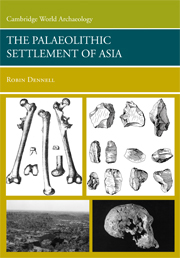Book contents
- Frontmatter
- Contents
- List of Tables, Figures, and Boxes
- Preface
- 1 Asia and Its Place in Palaeoanthropology
- 2 The African Background to the Colonisation of Asia
- 3 The Climatic and Environmental Background to Hominin Settlement in Asia before 1 MA
- 4 The Earliest Inhabitants of Southwest Asia
- 5 The Earliest Inhabitants of South and Southeast Asia and China
- 6 “Out of Africa 1” Reconsidered and the Earliest Colonisation of Asia
- 7 The Climatic and Environmental Background to Hominin Settlement in Asia between ca. 1 Ma and the Last Interglacial
- 8 The Middle Pleistocene Archaeological Record for Southwest and Central Asia
- 9 The Middle Pleistocene Archaeological Record of the Indian Subcontinent
- 10 The Middle Pleistocene Archaeological Record of China and Southeast Asia
- 11 Human Evolution in Asia during the Middle Pleistocene
- 12 Concluding Remarks
- Appendix 1 The Sizes of Countries and Regions in Asia, with Comparative Examples
- Appendix 2 Geographical Coordinates of Principal Early Palaeolithic Sites in Asia
- Appendix 3 Geographical Coordinates of Geological Sections and Cores
- Appendix 4 English Names of Various Mammals Recorded in Asia
- Bibliography
- Index
7 - The Climatic and Environmental Background to Hominin Settlement in Asia between ca. 1 Ma and the Last Interglacial
Published online by Cambridge University Press: 05 June 2012
- Frontmatter
- Contents
- List of Tables, Figures, and Boxes
- Preface
- 1 Asia and Its Place in Palaeoanthropology
- 2 The African Background to the Colonisation of Asia
- 3 The Climatic and Environmental Background to Hominin Settlement in Asia before 1 MA
- 4 The Earliest Inhabitants of Southwest Asia
- 5 The Earliest Inhabitants of South and Southeast Asia and China
- 6 “Out of Africa 1” Reconsidered and the Earliest Colonisation of Asia
- 7 The Climatic and Environmental Background to Hominin Settlement in Asia between ca. 1 Ma and the Last Interglacial
- 8 The Middle Pleistocene Archaeological Record for Southwest and Central Asia
- 9 The Middle Pleistocene Archaeological Record of the Indian Subcontinent
- 10 The Middle Pleistocene Archaeological Record of China and Southeast Asia
- 11 Human Evolution in Asia during the Middle Pleistocene
- 12 Concluding Remarks
- Appendix 1 The Sizes of Countries and Regions in Asia, with Comparative Examples
- Appendix 2 Geographical Coordinates of Principal Early Palaeolithic Sites in Asia
- Appendix 3 Geographical Coordinates of Geological Sections and Cores
- Appendix 4 English Names of Various Mammals Recorded in Asia
- Bibliography
- Index
Summary
INTRODUCTION
The earth's climate changed significantly between 1 Ma and 500 ka, most notably in the frequency, amplitude, and duration of cold, arid periods. Compared with the Early Pleistocene (Chapter 3), these occurred less frequently but lasted longer, and the volume of global ice (as indicated by the marine isotope record) was much greater. In Europe and North America, these cold periods were characterised by extensive ice sheets, the earliest of which in Europe occurred in Marine Isotope Stage (MIS) 16, ca. 650–620 ka (Head and Gibbard 2005:13). Many of these cold periods began gradually but ended abruptly. These cold conditions have dominated the last 600,000 years, and were interrupted by relatively short periods of higher temperatures, precipitation, and sea levels, with the partial exception of the unusually long interglacial MIS 11 (423–362 ka). Depending upon whether the duration of these warm, moist (= interglacial) periods was as little as only ca. 11,000 years (as indicated by the warmest part of the last interglacial, MIS 5e), or as long as 61,000 years, as in MIS 11, conditions across Eurasia would have been colder and drier than today for most of the last 600,000–800,000 years. A final important detail is that both glaciations and interglacials during the Middle Pleistocene experienced numerous short-term (submillennial or even decadal) climatic oscillations, the effects of which on hominins might have been major (see, e.g., McNabb 2005) but cannot be evaluated for Asia without major improvements in the quality of archaeological data.
- Type
- Chapter
- Information
- The Palaeolithic Settlement of Asia , pp. 203 - 258Publisher: Cambridge University PressPrint publication year: 2008



